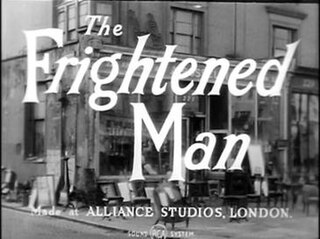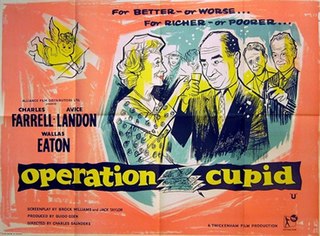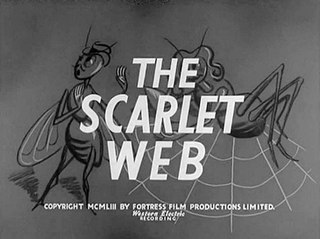
Sir Bruce Lovat Seton, 11th Baronet was a British actor and soldier. He is best remembered for his eponymous lead role in Fabian of the Yard.

There's Always a Thursday is a 1957 British crime film directed by Charles Saunders and starring Charles Victor, Jill Ireland, Lloyd Lamble and Robert Raglan. Much of the film was shot at Southall Studios.

Two on the Tiles is a 1951 British comedy film directed by John Guillermin and starring Herbert Lom, Hugh McDermott and Brenda Bruce. It was made at the Walton Studios by the independent Vandyke Productions for release as a second feature. It was one of three back-to-back productions Guillermin directed for the company at Walton Studios, along with Smart Alec and Four Days,. It was released in the U.S. as School for Brides.
Badger's Green is a 1949 British comedy film directed by John Irwin and starring Barbara Murray, Brian Nissen, Garry Marsh and Kynaston Reeves.
Golden Arrow is a 1949 British comedy film directed by Gordon Parry and starring Burgess Meredith, Jean-Pierre Aumont and Paula Valenska. It was shot at Teddington Studios. The film was eventually released as a second feature, despite a reasonably high budget and well-known cast. It was given an American release in 1953 by United Artists under the title The Gay Adventure. It takes its title from the Golden Arrow train service.

Paul Temple's Triumph is a 1950 British crime film directed by Maclean Rogers and starring John Bentley, Dinah Sheridan and Jack Livesey. It was the third in the series of four Paul Temple films made at Nettlefold Studios and was an adaptation of the Francis Durbridge radio serial News of Paul Temple (1939). Temple is on the trail of a gang of international criminals trying to steal atomic secrets.
The Case of Charles Peace is a 1949 British crime film directed by Norman Lee and starring Michael Martin Harvey, Chili Bouchier and Valentine Dyall. It is based on the real-life Victorian murderer Charles Peace.

Trouble with Eve is a 1960 British second feature comedy film directed by Francis Searle and starring Hy Hazell, Sally Smith, Robert Urquhart and Garry Marsh. It was based on the play Widows are Dangerous by June Garland. It was shot at Walton Studios. The film was released in the U.S. in 1964 as In Trouble With Eve.

The Frightened Man is a 1952 British crime film directed by John Gilling and starring Dermot Walsh, Barbara Murray and Charles Victor. It is also known by the alternative title of Rosselli and Son and was shot at Twickenham and Riverside Studios. Its plot concerns a son of an antiques dealer who suffers a dramatic fall from grace.
James Wilson was a British cinematographer.

Operation Cupid is a 1960 British comedy film directed by Charles Saunders and starring Charles Farrell, Avice Landone and Wallas Eaton. The screenplay concerns a gang of criminals who win a marriage agency during a card game and plan to use it to arrange a lucrative marriage for one of their gang to an extremely wealthy heiress. It was made at Twickenham Studios in west London, for release as a supporting feature.

The Story of Shirley Yorke is a 1948 British drama film directed by Maclean Rogers and starring Derek Farr, Dinah Sheridan and Margaretta Scott. The film was based on the play The Case of Lady Camber by Horace Annesley Vachell. It was made at the Nettlefold Studios in Walton-on-Thames. Art direction was by Charles Gilbert.

The Scarlet Web is a 1954 British second feature crime film directed by Charles Saunders and starring Griffith Jones, Hazel Court and Zena Marshall.

A Case for PC 49 is a 1951 British mystery film directed by Francis Searle and starring Brian Reece, Joy Shelton and Christine Norden. It was made by Hammer Films at Bray Studios. The film was based on a popular radio series, which already been adapted into the 1949 production The Adventures of PC 49. It was released as a second feature.

The Dark Light is a 1951 British thriller film directed by Vernon Sewell and starring Albert Lieven, David Greene, Norman Macowan. It was filmed at a rented country estate in Gilston and on location around Portsmouth. Sewell used his own boat.
Celia is a 1949 British comedy thriller film directed by Francis Searle and starring Hy Hazell, Bruce Lester and John Bailey. Made as a second feature by Hammer Films, it was based on a radio serial.
Trouble in the Air is a 1948 British comedy film directed by Charles Saunders and starring Freddie Frinton, Jimmy Edwards, and Bill Owen. It was made at Highbury Studios as a second feature. The film's sets were designed by the art director Don Russell.
Loyal Heart is a 1946 British drama film directed by Oswald Mitchell and starring Percy Marmont, Harry Welchman and Patricia Marmont. The film portrays rivalry in the sheep farming community.

Freedom to Die is a 1961 British second feature crime thriller film directed by Francis Searle, starring Paul Maxwell and Felicity Young.
Racing Romance is a 1937 British comedy film directed by Maclean Rogers and starring Bruce Seton, Marjorie Taylor and Eliot Makeham. It was made as a quota quickie for release by RKO Pictures.












